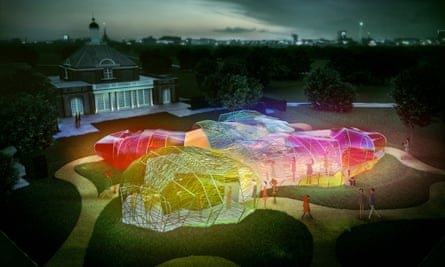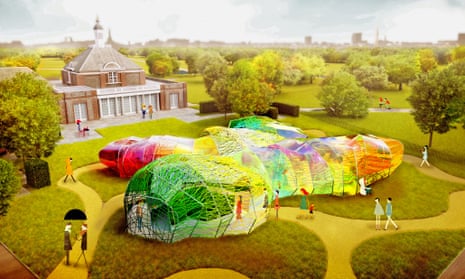A psychedelic labyrinth will land in Kensington Gardens this summer, courtesy of young Spanish architects Selgas Cano, whose plans to weave a colourful plastic cocoon for the 15th annual Serpentine pavilion have been unveiled today. Formed from layers of jazzy plastic fabric and coloured webbing stretched over a framework of interlocking tunnels, it looks as if an exotic caterpillar might have nibbled on a magic mushroom before spinning its chrysalis.
“It will be absolutely experimental from every angle you look through it,” Jose Selgas told me, when he and his partner Lucia Cano were selected for the prestigious commission in December. In today’s announcement, the architects (who work in their own cocoon, buried in a forest outside Madrid) say they have “sought a way to allow the public to experience architecture through simple elements,” creating a “journey through the space, characterised by colour, light and irregular shapes with surprising volumes.”
It follows on from another cocoon-shaped pavilion last year, designed by a similarly little-known architect, the Chilean Smiljan Radic. While his papery pod had an organic quality, this year’s supercharged structure couldn’t look more synthetic, in keeping with the Spanish architects’ penchant for playful plastic structures.
Serpentine directors Julia Peyton-Jones and Hans Ulrich Obrist said they wanted a party pavilion for the annual initiative’s 15th birthday – and a festive folly they have certainly got. The structure could be what’s left over after one of their fundraising shindigs, a pile of deflated balloons tangled up with party-popper streamers. It exudes joy, mischief and a welcome dose of Spanish sunshine, although, as ever with these pavilions, the devil will be in the detail. From this image, there’s a danger it could look like a half-baked student project, hashed together on a shoestring.
“We thought we would have a huge budget for this project, but in the end it is very small,” said Selgas, echoing the impression other young practices have had on receiving this esteemed commission, before realising it is more a charitable labour of love, but good for the CV. Budget limitations have forced the architects to rethink their original plan – to make a structure that pushed the boundaries of a single material – and sent them back to the drawing board less than six months before the opening date.

“We realised we weren’t making a piece of art – it’s architecture that obeys a programme – so we had to start again, almost from scratch,” Selgas told Icon magazine earlier this month. “Essentially, we’re building a theatre, in a royal park, where you sell alcohol. So the regulations are huge; it’s not like you can build whatever you want. We don’t have carte blanche.”
He had originally spoken of a structure that would “really embrace the garden,” but has since admitted that the pavilion “will sit in a piece of garden of little interest.” “It’s flat, empty and stupid to some point,” he added, “so we wanted to create a building that has its own garden.”
The double-skinned design will create a “secret corridor” between the outer and inner layers, leading visitors from multiple entrances into a kaleidoscopic stained-glass-effect interior. It might look like a jumbled mess from the outside, but it could well offer a magical spatial experience within, taking you from a warm red entrance through cold moody blue passages to chambers bathed in optimistic yellow, framing painterly glimpses of other colour-seeking explorers through its folded layers of ETFE plastic membranes and woven webbing.
The design bears a debt to the inflatable Dreamspace labyrinths developed by British sculptor Maurice Agis, who constructed glowing networks of tunnels and caves in coloured PVC. His career came to a tragic end in 2006 when one of his structures was caught by a gust of wind and took flight, killing two people and injuring 13 others. He was convicted of health and safety breaches in 2009, fined £10,000 (reduced to £2,500 on appeal), and died two months later. His psychedelic genius lives on in innumerable imitators, who hire out their inflatable mazes to music festivals and village fetes around the world.
Whatever the architectural community makes of it, Selgas Cano’s pavilion is likely to be a huge hit with children, just like these mazes. But whether it offers something richer and more complex than an off-the-peg inflatable attraction remains to be seen.
- The 2015 Serpentine Pavilion by Selgas Cano will be on show 25 June – 18 October at the Serpentine Gallery, Kensington Gardens, London W2.

Comments (…)
Sign in or create your Guardian account to join the discussion